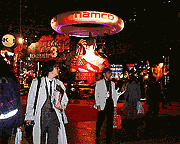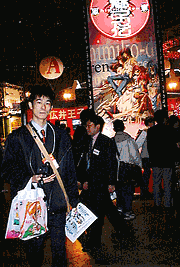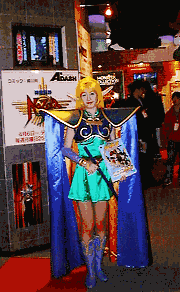 |

 |
 |


20-23 March 1998
Makuhari Messe
(Japan Convention Center, Chiba)
—by Ivevei Upatkoon
Almost three years have passed since the first Tokyo Game Show was held in
August 1996 by the Computer Entertainment Software Association
(CESA). This
spring's Show was the fourth, and reflecting the boom in video games it
utilized all eight rooms at Makuhari Messe, rather
impressive considering the last one used only six rooms but drew over
140,000 visitors. This year's event fell on the Japanese school system's
Spring Break, and attendance was expected to increase accordingly.
|
 |
 |







 |
 |
 I attended Show on press day, March 20th, and was amazed to
see that it was
still filled with people. As security was pretty lax, it was extremely easy
to obtain a press pass, and I think many people took advantage of this
fact. While many panels were not running, a good number of booths did have
cosplay shows and other events for the benefit of the reporters and
visitors. I attended Show on press day, March 20th, and was amazed to
see that it was
still filled with people. As security was pretty lax, it was extremely easy
to obtain a press pass, and I think many people took advantage of this
fact. While many panels were not running, a good number of booths did have
cosplay shows and other events for the benefit of the reporters and
visitors.
 Being out of the video gaming loop for quite a while,
I really had little
idea of what the big name titles for this year were. Instead, I just
wandered around and looked at whatever took my fancy. Because I did not
realize that they were using two additional rooms, it took me forever to
find the major makers. Sega, Square, Bandai, Konami, and other big names
were all located together. In fact, the Sega, Square and Tecmo booths were
set up all facing each other! (This particular spot was hellish on the
public days. I was at the Square booth all day on Sunday the 22nd waiting
for Kasahara Hiroko's appearance at the SOUKAIGI
event and darn near
expired from fighting through the crowds at lunch time, but that is another
story.) Being out of the video gaming loop for quite a while,
I really had little
idea of what the big name titles for this year were. Instead, I just
wandered around and looked at whatever took my fancy. Because I did not
realize that they were using two additional rooms, it took me forever to
find the major makers. Sega, Square, Bandai, Konami, and other big names
were all located together. In fact, the Sega, Square and Tecmo booths were
set up all facing each other! (This particular spot was hellish on the
public days. I was at the Square booth all day on Sunday the 22nd waiting
for Kasahara Hiroko's appearance at the SOUKAIGI
event and darn near
expired from fighting through the crowds at lunch time, but that is another
story.)
 Most of the titles exhibited at this Show will have already
been released
by the time this issue of EX hits the virtual
shelves. In fact, an
overwhelming number of titles were scheduled for release several days after
TGS, in time for payday at the end of March.
While this meant that the
major attractions were fully playable, it would have been nice to see games
we could have looked forward to in several months. Most of the titles exhibited at this Show will have already
been released
by the time this issue of EX hits the virtual
shelves. In fact, an
overwhelming number of titles were scheduled for release several days after
TGS, in time for payday at the end of March.
While this meant that the
major attractions were fully playable, it would have been nice to see games
we could have looked forward to in several months.
 Probably the most impressive booth this year was Namco's. A
mammoth exhibit
that featured almost exclusively its flagship TEKKEN 3
for the PSX, it had
two levels of PSX machines running
this beautiful conversion, and even on
press day I did not have more than a few minutes to feel out the game.
There were about 20 cosplay girls dressed up as Xiaoyu, and the show they
put on featured dancing and dry ice. Video games have certainly come a long
way since I first started up my Nintendo! Probably the most impressive booth this year was Namco's. A
mammoth exhibit
that featured almost exclusively its flagship TEKKEN 3
for the PSX, it had
two levels of PSX machines running
this beautiful conversion, and even on
press day I did not have more than a few minutes to feel out the game.
There were about 20 cosplay girls dressed up as Xiaoyu, and the show they
put on featured dancing and dry ice. Video games have certainly come a long
way since I first started up my Nintendo!
 The next booths I hit were SNK's and
Capcom's. No matter what they say, I
still have a special fondness for 2D fighting games.
SNK's KING OF FIGHTERS
'97 for the Sega Saturn looked pretty good considering the size of the
original game, and I was very surprised to see Capcom's
VAMPIRE SAVIOR,
also for the Saturn. Utilizing the 4 meg RAM cart,
it looked to have all
the frames, plus very short load time. The recent crop of Capcom games for
the Saturn have truly been incredible conversions, leaving me to bemoan all
the more the slow but sure demise of this system.
PSX titles topped 50% of
the games exhibited, and the SS's share
had tumbled to little over 17%. The next booths I hit were SNK's and
Capcom's. No matter what they say, I
still have a special fondness for 2D fighting games.
SNK's KING OF FIGHTERS
'97 for the Sega Saturn looked pretty good considering the size of the
original game, and I was very surprised to see Capcom's
VAMPIRE SAVIOR,
also for the Saturn. Utilizing the 4 meg RAM cart,
it looked to have all
the frames, plus very short load time. The recent crop of Capcom games for
the Saturn have truly been incredible conversions, leaving me to bemoan all
the more the slow but sure demise of this system.
PSX titles topped 50% of
the games exhibited, and the SS's share
had tumbled to little over 17%.
 But that's not to say it isn't going out with a bang!
One of my favorite
games of 1996/7 was SAKURA TAISEN,
and so I made a beeline for the Sega
booth as soon as I had determined its location. As expected, it had rows of
demos for SAKURA TAISEN 2, one
set for the improved battle system, and one
for the revised interaction sequences. I will say this much—the opening
animation is great! The in-game graphics are also gorgeous. Few sequels
transcend their predecessors, but I doubt any fan would dispute it in this
case. But that's not to say it isn't going out with a bang!
One of my favorite
games of 1996/7 was SAKURA TAISEN,
and so I made a beeline for the Sega
booth as soon as I had determined its location. As expected, it had rows of
demos for SAKURA TAISEN 2, one
set for the improved battle system, and one
for the revised interaction sequences. I will say this much—the opening
animation is great! The in-game graphics are also gorgeous. Few sequels
transcend their predecessors, but I doubt any fan would dispute it in this
case.
 The Sega booth also played host to other third party games
as well as their
in-house production of HOUSE OF THE DEAD.
I liked what I saw of DRAGON
FORCE II (With character designs by
Yuuki Nobuteru of
LODOSS and ESCAFLOWNE,
how could one not be impressed?). In addition,
there were
screen shots of the SHOJO KAKUMEI UTENA game and
NEON GENESIS EVANGELION:
GIRLFRIEND OF STEEL. The Sega booth also played host to other third party games
as well as their
in-house production of HOUSE OF THE DEAD.
I liked what I saw of DRAGON
FORCE II (With character designs by
Yuuki Nobuteru of
LODOSS and ESCAFLOWNE,
how could one not be impressed?). In addition,
there were
screen shots of the SHOJO KAKUMEI UTENA game and
NEON GENESIS EVANGELION:
GIRLFRIEND OF STEEL.
 With Square right across from Sega, it was easy enough to walk
over. Right
away, I was assailed by the massive video screen at the back of the stage,
which showed demos of all their games due out.
PARASITE EVE with its
mouthwatering CG movies, EHRGEIZ for fighting fans,
SOUKAIGI and BRAVE
FENCER MUSASHIDEN for those looking for 3D action
RPGs, BUSHIDO BLADE 2,
and FINAL FANTASY V for us ancient
RPG dinosaurs—overall one of the
strongest lineups at the Show. With Square right across from Sega, it was easy enough to walk
over. Right
away, I was assailed by the massive video screen at the back of the stage,
which showed demos of all their games due out.
PARASITE EVE with its
mouthwatering CG movies, EHRGEIZ for fighting fans,
SOUKAIGI and BRAVE
FENCER MUSASHIDEN for those looking for 3D action
RPGs, BUSHIDO BLADE 2,
and FINAL FANTASY V for us ancient
RPG dinosaurs—overall one of the
strongest lineups at the Show.
 There were too many other exhibits for me to cover, but a few that caught
my eye were the (both incomplete) PATLABOR THE GAME
and MACROSS DIGITAL
MISSION VF-X 2, from Bandai Visual. Given the company's track record, it is a
little too much to expect anything spectacular, but I have to admit
VF-X 2
looked pretty good. Another game that stood out was
STOLEN SONG from Sony,
the premise being that you play an air guitar and earn points according to
rhythm. It was nice to see that, thanks to
PARAPPA THE RAPPER, video games
are started to branch out into more novel fields. One thing that did sorely
disappoint me was the absence of DRACULA X
for the Saturn at Konami's
booth. It seems that this game has been delayed indefinitely, leaving this
reviewer to both curse in frustration at not being able to play Maria, and
sigh in thanks for the relief afforded her pocketbook. There were too many other exhibits for me to cover, but a few that caught
my eye were the (both incomplete) PATLABOR THE GAME
and MACROSS DIGITAL
MISSION VF-X 2, from Bandai Visual. Given the company's track record, it is a
little too much to expect anything spectacular, but I have to admit
VF-X 2
looked pretty good. Another game that stood out was
STOLEN SONG from Sony,
the premise being that you play an air guitar and earn points according to
rhythm. It was nice to see that, thanks to
PARAPPA THE RAPPER, video games
are started to branch out into more novel fields. One thing that did sorely
disappoint me was the absence of DRACULA X
for the Saturn at Konami's
booth. It seems that this game has been delayed indefinitely, leaving this
reviewer to both curse in frustration at not being able to play Maria, and
sigh in thanks for the relief afforded her pocketbook.
 Overall, however, this Tokyo Game Show was without question a very
successful affair. If the exhibits are anything to go by, simulations
continue to be a staple of the Japanese gaming appetite, but role-playing
games and adventure games have also grown tremendously. Conversely, the
share of traditional sports and shooting games has fallen. Personally I
continue to be a staunch supporter of 2D games, but "the times they are
a-changing" as they say, and the video game industry looks set for a very
bright
future. Overall, however, this Tokyo Game Show was without question a very
successful affair. If the exhibits are anything to go by, simulations
continue to be a staple of the Japanese gaming appetite, but role-playing
games and adventure games have also grown tremendously. Conversely, the
share of traditional sports and shooting games has fallen. Personally I
continue to be a staunch supporter of 2D games, but "the times they are
a-changing" as they say, and the video game industry looks set for a very
bright
future.  |
 |









